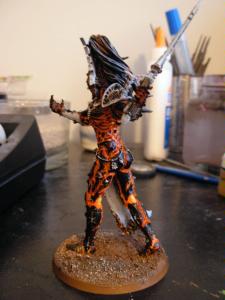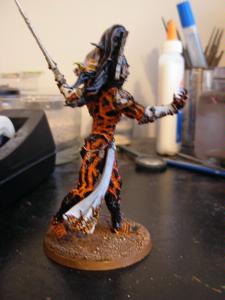Exalted Avatar 0-1




Rules
| Points | WS | BS | S | T | W | I | A | LD | SV
| | 750 | 10 | 10 | 8 | 8 | 8 | 10 | 6 | 10 | 2+/4+
|
Gargantuan
Daemon: The avatar is considered a daemon.
Fearsome: the avatar is terrifying, a molten embodiment of an angry god! If an enemy unit has to take a morale check after losing a close combat, they do so at -2 leadership.
Wailing Doom: Can be fired in shooting phase.
Range 24” S:8 AP:1 3” blast Melta
Inferno: The avatar can cause flames to erupt from the ground near him
18” Strength 7 AP: 3 Template
Molten Blood: strength: 5 AP: 4 hit on model that wounds avatar
Molten Body: Is never wounded by weapons that have the melta special rule or are flame/heat based in their nature.
Inspiration: Any eldar model within 18 inches of the avatar receives the fearless universal rule and a plus one to both their weapon skill and initiative.
War God: Always hits on a 3+ regardless of other modifiers.
Khaine Incarnate: If this avatar is used than no other avatar may be fielded by the Eldar army. Instead of fielding multiple codex Eldar avatars the war god is presented in his exalted from. Allies from other craft-worlds will allow their avatars to contribute their essence to create the forge world version, so their avatar will not take part in the battle. Treat this rule as a suggestion when engaging in battles with allied players as it is unreasonable to alter their army to suit yours.
Test Combats
I pitted my avatar rules against other GWS units who seem to embody similar roles as my avatar; the three daemon lords, and the two C’tan. This was done in order to determine both the combat effectiveness of my avatar when compared to GWS units and to gauge pricing of the unit – I hoped to preserve the general relation between the standard greater daemons verse the avatar when comparing my version to the apocalypse daemon lord versions. I tested combat capabilities by starting both units in combat without the benefit of a charge and used a combat calculator set at 1000 test fights. Bare in mind this is an imperfect method of examination as it did not account of psychic abilities, ballistic capabilities, or other unique talents the characters possess that could come into play during a combat phase – but it does provide a simple means to see how my avatar compares to daemon lords and C’tan both in combat and pricing in a basic sense.
Avatar Verse An’Ggrath the Unbound Khorne Daemon Lord
Percent win: 15.4% Percent lost: 84.6% Tie: 0%
Average Number of Combat Rounds: 5
Point Difference: An’Ggrath is 100 more expensive than the avatar
Avatar Verse Zarakynel Slaanesh Daemon Lord
Percent win: 34.3% Percent lost: 51.60% Tie: 14.1%
Average Number of Combat Rounds: 5
Point Difference: Avatar cost close to 100 points more than Zarakynel
Avatar Verse Scabeiathrax The Bloated Nurgle Daemon Lord
Percent win: 3.2% Percent lost: 96.8 & Tie: 0%
Average Number of Combat Rounds: 7
Point Difference: Scabeiathrax is 20 – 30 points more expensive than avatar
Avatar Verse Nighbringer C’tan
Percent win: 42.0% Percent lost: 58.0% Tie: 0%
Average Number of Combat Rounds: 4
Point Difference: Avatar is more than double the point value of the nightbringer
Avatar Verse Deceiver C’tan
Percent win: 71.6% Percent lost: 28.4% Tie: 0%
Average Number of Combat Rounds: 5
Point Difference: Avatar is more than double the point value of the deceiver
Fluff Justification
My Forge World Avatar rules represents the avatar being used in an engagement that was foreseen centuries before by the farseers of the craftworld. During this time the Avatar is nurtured and coaxed by the eldar - the avatar reaches across the webway to other avatars and borrows some of their essence. While this does not reconstitute the war god to his pre-sundered form, it does augment his abilities greatly. When the time for the battle emerges the avatar has swelled with the essences of many avatars throughout the galaxy.
I felt it was important to create a sensibly explanation on how there are two different rules for what is essentially the same entity.
Or
My more drastic suggestion is to disregard the old rules entirely and move the avatar to apocalypse games in which it receives rules more appropriate to the forge world model and the character’s role in 40K. The fluff behind the avatar is that he arises after the sacrifice of an exarch and at a time when the entirety of the craftworld is driven to war. He really does not belong in the casual 1000 or 2000 point games from a fluff perspective. I have not had a use for my standard avatar for a while, and I noticed that his presence is absent from the majority of games involving eldar. Perhaps it is time for GWS to do to the eldar avatar what it is rumored they’re planning to do for the C’tan and move them both to Apocalypse games with more impress capabilities.
Update: I found some more fluff supporting my avatar in the new tyranid codex. When the battle in Iyanden took place the avatar moved to attack the “super” hive tyrant (possible swarmlord or possibly even more impressive construct); concerned about its destruction the tyranid leader sent a dozen carnifexes out to destroy the avatar, which they accomplished.
The avatar was quoted as being able to destroy the creature, who sent the carnifexes to destroy the threat fearing for its own survival. The tyranid leader destroyed wraithlords with ease, but sensed its destructor at the avatar’s hands. This suggests an avatar far more substantial than the rules represent. Also the act of sending a dozen carnifexes to dispatch the avatar also shows the level of threat the avatar represented to the tyrant. Under standard rules 3 or 4 carnifexes would have been enough to near completely guarantee victory. I don't think it is typical of tyranids to show off for such an exception display of over kill.
I used the combat calculator again to test out my rules against 12 carnifexes and out of 500 trials the bugs had a 100% win rate. I then tested my avatar verse 6 carnifexes and the win rate for the tyranids dropped to 73.6%. Both combats were done without either side receiving a charge, gaining the charge obviously swings the advantage even further to the carnifexes. Based on this fluff, it seems GWS is, at least in its recent background material, supporting a significantly more powerful avatar than currently represented by the rules.